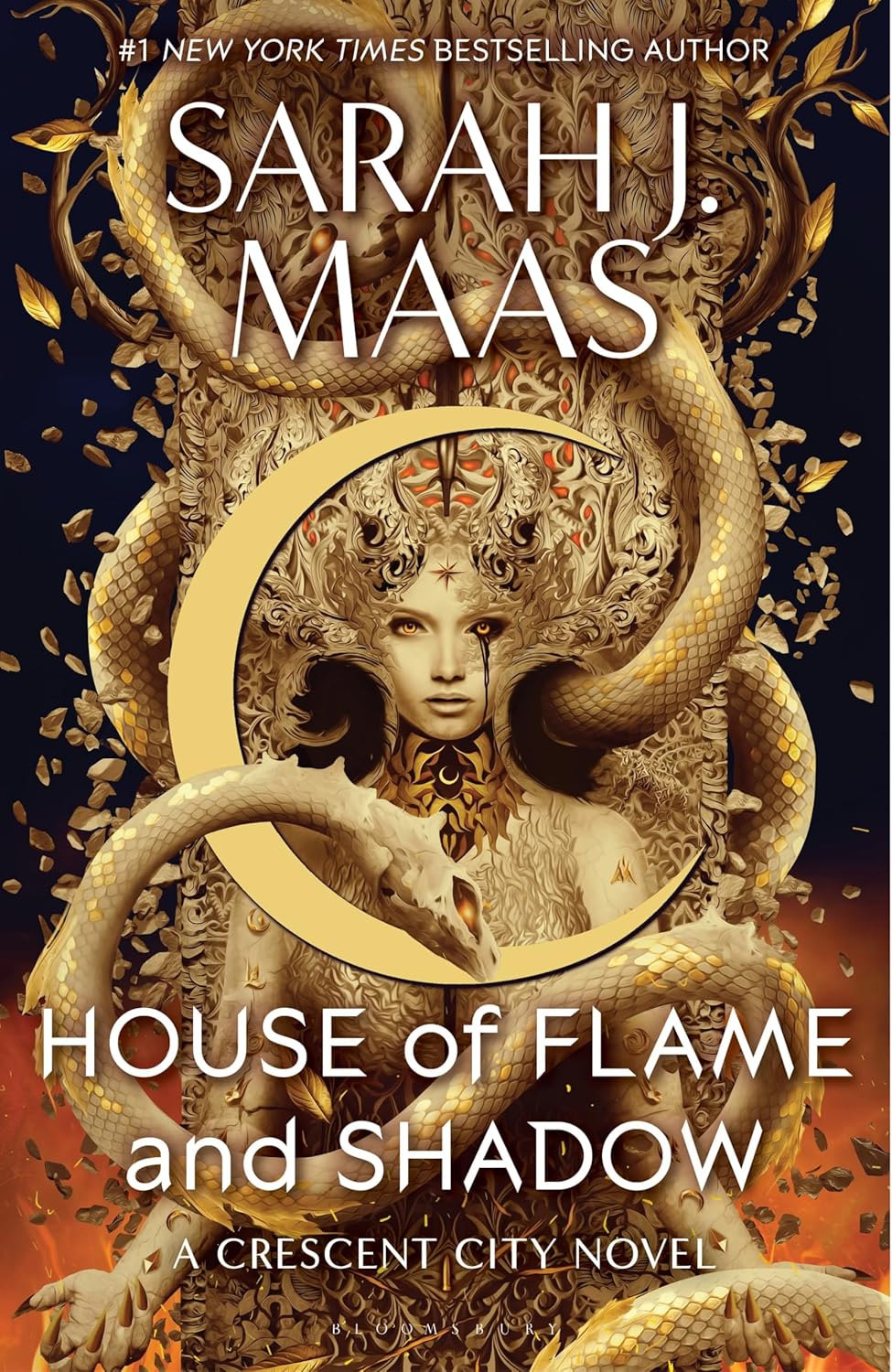In-Depth Review: House of Flame and Shadow (Crescent City, #3) by Sarah J. Maas
In-Depth Review: House of Flame and Shadow (Crescent City, #3) by Sarah J. Maas
By Nandy

Synopsis House of Flame and Shadow
House of Flame and Shadow is a thunderous conclusion to the first arc of Sarah J. Maas’s Crescent City series, delivering a kaleidoscope of interstellar stakes, heart-wrenching sacrifices, and universe-shattering revelations. The novel picks up immediately after the cliffhanger of House of Sky and Breath, with Bryce Quinlan stranded in Prythian—the world of Maas’s A Court of Thorns and Roses—while her mate, Hunt Athalar, and brother, Ruhn Danaan, endure brutal torture in the Asteri’s dungeons. Bryce’s mission to return to Midgard intertwines with the fates of Prythian’s most enigmatic figures, including Nesta Archeron and Azriel, as they uncover ancient secrets about the Dusk Court, the Asteri’s origins, and Bryce’s Starborn lineage.
Meanwhile, Midgard teeters on collapse. The Asteri’s grip tightens, rebellions ignite, and alliances fracture. Lidia Cervos (the Hind), a double agent with a devastating past, becomes pivotal to the resistance, while Ithan Holstrom grapples with his unexpected role as Prime of the wolves. The narrative crescendos in a battle spanning worlds: Bryce wields the Starsword and Truth-Teller to sever the Asteri’s hold, Hunt confronts his destiny as a weapon of fate, and Ruhn embraces his leadership as Starborn heir. The finale ties together threads from ACOTAR and Throne of Glass, culminating in a tear-jerking sacrifice, a democracy-forging revolution, and a cosmic reset that redefines love, loyalty, and legacy.
Author Background Sarah J. Maas,
Sarah J. Maas, the #1 New York Times bestselling author, has redefined modern fantasy with her Throne of Glass, A Court of Thorns and Roses, and Crescent City series. Known for intricate world-building, morally gray characters, and romances that spark fandom wars, Maas has sold over 30 million books globally. House of Flame and Shadow solidifies her reputation as a master of genre-blending, merging urban fantasy, sci-fi, and epic romance into a saga that spans galaxies.
Maas’s evolution from YA to adult fantasy is evident here, with mature themes of trauma, systemic oppression, and self-determination. Critics praise her boldness in weaving crossover elements, though debates about pacing and character choices persist. Still, as Entertainment Weekly notes, Maas crafts “a dizzying, suspenseful whirl that surprises at every turn”.
Critical Analysis House of Flame and Shadow
1. Plot Structure and Pacing
At 816 pages, House of Flame and Shadow is a sprawling epic, yet its pacing mirrors the urgency of a ticking clock. The first third alternates between Bryce’s interdimensional odyssey in Prythian and Hunt/Ruhn’s harrowing imprisonment, balancing exposition with adrenaline. While some critics argue the early chapters feel slow, these moments lay crucial groundwork: Bryce’s discovery of the Dusk Court’s history and Lidia’s double-agent machinations deepen the lore and emotional stakes.
The plot accelerates into a cinematic third act, featuring a mer rebellion, a showdown in the Starlight Caves, and a galaxy-spanning battle against the Asteri. Maas’s decision to intertwine Bryce’s arc with Nesta and Azriel’s journey pays off brilliantly, particularly in scenes where Prythian’s magic clashes with Midgard’s tech. The final 200 pages are a masterclass in payoff, resolving long-standing mysteries (e.g., Jesiba’s true identity, the Under-King’s ties to Throne of Glass) while leaving threads for future books.
2. Character Development
- Bryce Quinlan: Bryce’s evolution from party girl to revolutionary is polarizing but profound. Her ruthlessness—leaving allies like Cormac behind, dismissing Hunt’s trauma—sparks debate, yet underscores her Aelin-esque pragmatism. Her final sacrifice and rebirth as a unifying leader redefine heroism in Maas’s universe.
- Hunt Athalar: Hunt’s arc is a raw exploration of agency vs. fate. Tortured physically and emotionally, his reunion with Bryce—though criticized for lacking warmth—echoes real-world struggles with PTSD and trust. His quiet declaration, “I am yours, and you are mine,” resonates as a testament to enduring love.
- Lidia Cervos: The undisputed MVP. Lidia’s duality as a mother, spy, and flame-wielder adds layers to Maas’s roster of heroines. Her romance with Ruhn—a blend of star-crossed tension and mutual respect—steals the narrative, culminating in a jaw-dropping lineage reveal tied to Throne of Glass.
- Supporting Cast: Ithan’s rise as Prime and Tharion’s redemption, though divisive, reflect Maas’s knack for underdog arcs. Hypaxia’s necromancy and Jesiba’s sacrifice add mythic weight, while the Autumn King’s demise delivers poetic justice.
3. Themes and Symbolism
- Freedom vs. Control: The Asteri’s parasitic rule mirrors real-world authoritarianism, while Bryce’s dismantling of the Fae monarchy champions democracy—a bold narrative risk that sparks hope.
- Legacy and Sacrifice: From Danika’s posthumous influence to Jesiba’s final act, the novel asks: What world will we leave for those who come after?
- Interconnectedness: The crossover isn’t fan service but a thematic bridge. Nesta’s growth in Prythian parallels Bryce’s in Midgard, proving healing is possible across worlds.
4. World-Building and Crossovers
Maas’s fusion of magic and modernity reaches new heights: think synth-drugs, mech suits, and black-hole portals juxtaposed with ancient rites like the Drop. The crossover with ACOTAR—while limited—adds depth, particularly in Nesta and Azriel’s roles. Their dynamic with Bryce crackles with tension, whether they’re battling Middengard Wyrms or decoding Asteri hieroglyphs. The inclusion of the Dusk Court and ties to Brannon’s lineage (Throne of Glass) expand the Maasverse into cosmic territory, setting the stage for future sagas.
Reception and Cultural Impact
House of Flame and Shadow debuted at #1 on bestseller lists, earning a 4.3/5 on Goodreads. Fans praise its emotional crescendos (Lidia’s sacrifice, Jesiba’s redemption) and theory-busting twists (Bryce’s Starborn-Asteri connection). Critics highlight pacing issues and Bryce’s polarizing choices, yet even skeptics admit the finale “rewards patience”.
The #CrescentCity hashtag trended for weeks, with fan art dissecting Ruhn’s starry eyes and Azriel’s shadows. Controversies—like the “magic bean” language solution—fueled debates, but Maas’s boldness in blending sci-fi and fantasy has been widely applauded.
Personal Opinion House of Flame and Shadow
As a Maas devotee, I devoured House of Flame and Shadow in two sleepless nights. Yes, the pacing stumbles early—Tharion’s subplot feels tangential—but the payoff is earthshaking. The crossover’s emotional beats floored me: Nesta’s vulnerability when hearing Bryce’s music, Azriel’s shadows recoiling at the Asteri’s corruption, and Rhysand’s cameo, which hints at future cosmic diplomacy.
Bryce’s arc, though divisive, moved me. Her flaws—recklessness, stubbornness—make her human. When she tells Hunt, “We’re the gods-damned cavalry,” it’s a rallying cry for every underdog. Lidia and Ruhn’s romance? Perfection. Their rooftop confession under a star-streaked sky is Maas at her best: tender, fierce, and unforgettable.
The finale’s democracy subplot, while abrupt, feels revolutionary. In a genre obsessed with monarchies, Bryce’s choice to “burn it all down” is a daring ode to collective power. And Jesiba’s sacrifice? I sobbed. Hard.
Is the book flawless? No. But as the Asteri crumble and Bryce’s city rises, House of Flame and Shadow reminds us why Maas reigns: she doesn’t just write stories—she builds legends.
Publication Details
- Title: House of Flame and Shadow (Crescent City, #3)
- Author: Sarah J. Maas
- Publisher: Bloomsbury Publishing
- Publication Date: January 30, 2024
- Pages: 848
- ISBN: 978-1635574104
- Genres: Urban Fantasy, Epic Fantasy, Romance
- Content Warnings: Graphic torture, war violence, themes of slavery, PTSD, and loss of loved ones.
Who Should Read This Book?
- Maasiverse Veterans: ACOTAR and Throne of Glass fans will scream at crossover reveals.
- Plot Junkies: Lovers of intricate schemes and galaxy-level stakes.
- Romance Enthusiasts: For Ruhn/Lidia’s slow burn and Hunt/Bryce’s resilient bond.
- Sci-Fantasy Buffs: If you crave dragons texting and black-hole portals, this is your jam.
Conclusion House of Flame and Shadow
House of Flame and Shadow is a magnum opus—a love letter to fans and a gateway to new worlds. While its heft and complexity may daunt newcomers, its heart—a tale of ordinary beings defying cosmic tyranny—is universal. Bryce Quinlan’s journey cements her as a legend, not for her power, but for her refusal to kneel.
As the Asteri fall and Midgard rebuilds, one truth remains: Through love, all is possible. And through Maas, all is epic.
Rating: ★★★★½ (4.5/5)
Recommendation: Buy it, annotate it, and join the theory-crafting chaos. Then reread ACOTAR—you’ll need it.
Further Exploration
- Dive into the Crescent City Wiki for deep dives on the Dusk Court and crossover theories.
- Listen to Maas’s interview on The Today Show discussing the trilogy’s evolution.
- Pair with a cinnamon latte (Bryce’s favorite) and ACOTAR’s A Court of Silver Flames for a thematic marathon.
Final Note: In a universe of infinite possibilities, House of Flame and Shadow is a supernova—blazing, beautiful, and utterly unforgettable. Now, excuse me while I stare at my bookshelf and whisper, “What’s next?”
- Review Lost Girls: An Unsolved American Mystery by Robert Kolker
- Review: House of Earth and Blood by Sarah J. Maas
- Review: House of Sky and Breath by Sarah J. Maas
- Review: House of Flame and Shadow by Sarah J. Maas
- Review: Let Them Theory
- Review: Great Big Beautiful Life (Reese’s Book Club)
- Review: Sunrise on the Reaping
- Review: The Lost Bookshop



